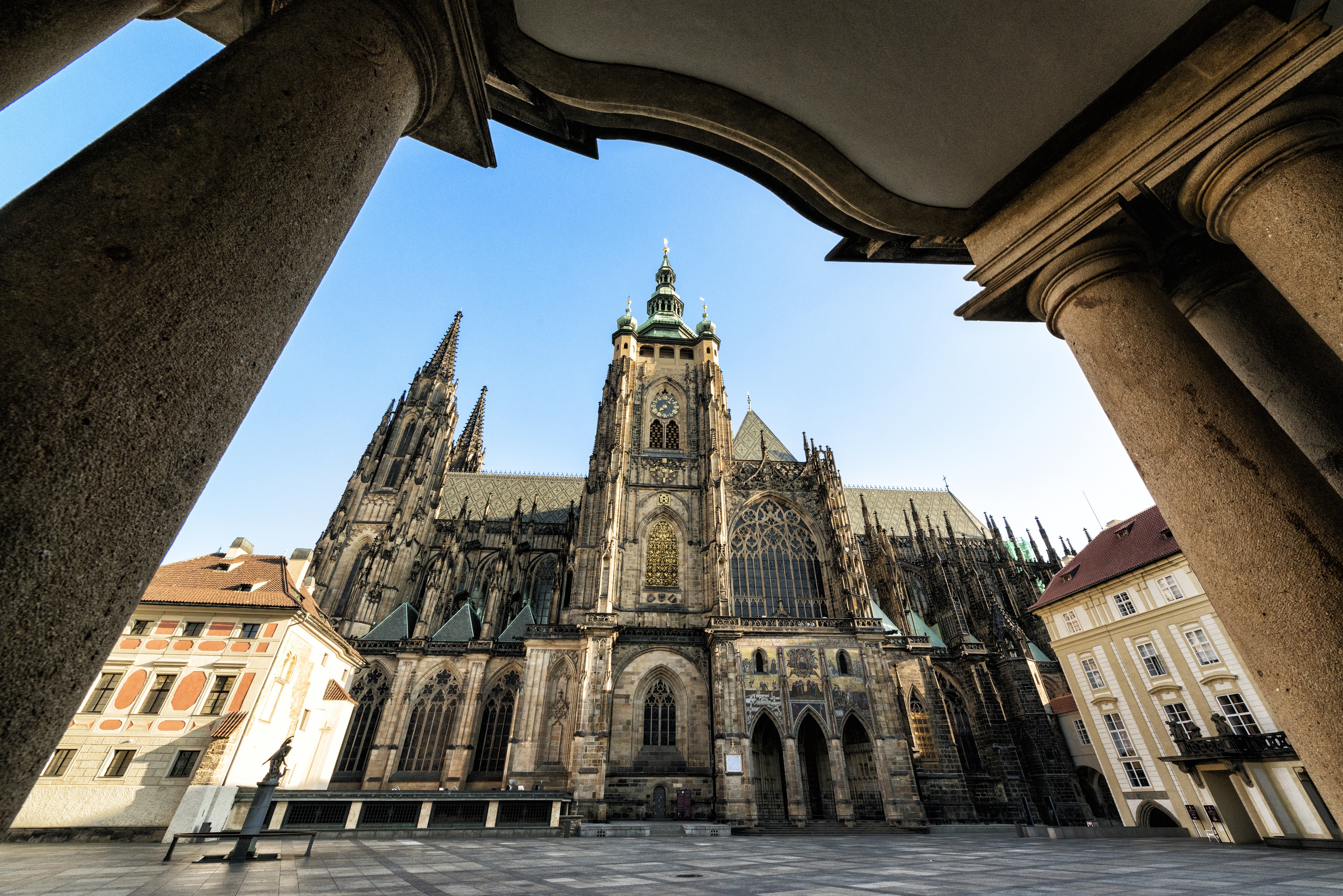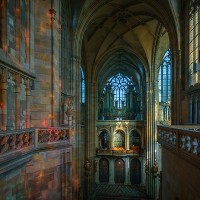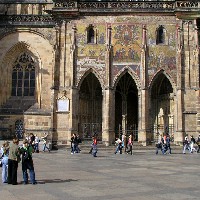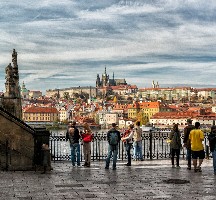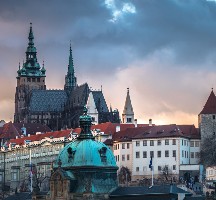Breadcrumbs navigation
Prague Castle - Cathedral of St Vitus, St Wenceslas and St Adalbert (Katedrála sv. Víta, Václava a Vojtěcha)
This Gothic cathedral, the spiritual symbol of the Czech state, was founded in 1344 on the site of the original Romanesque rotunda. The construction took nearly 600 years and was finally completed in 1929. Its impressive interior is home to such wonders as the beautifully decorated St Wenceslas Chapel with the tomb of St Wenceslas, the crypt where Czech kings are buried, and the Crown Chamber, where the Crown Jewels are kept.
- Monuments & Architecture
- church
- Gothic
- historicist styles
- views
- Prague Visitor Pass
Opening hours
-
- November – March
- Mon, Tue, Wed, Thu, Fri, Sat
- 09.00 – 16.00
-
- Sun
- 12.00 – 16.00
-
- April – October
- Mon, Tue, Wed, Thu, Fri, Sat
- 09.00 – 17.00
-
- Sun
- 12.00 – 17.00
Last entrance 20 minutes before closing time.
Changes to opening hours possible, especially with regard to the holding of religious services
- during religious ceremonies it is not possible to visit the cathedral.
Practical information
- the historical part (including St Wenceslas Chapel and the tombstones of Přemyslid kings and princes) is accessible only with a ticket for the Prague Castle Basic Tour (CZK 450 | CZK 300 | CZK 950)
- the “St Vitus’ Cathedral Up Close” guided tour is available, which includes the Royal Tomb and St Wenceslas Chapel.
Advance booking is required at www.hrad.cz - access is free only to the front neo-Gothic part of the cathedral
When entering the Prague Castle complex, visitors are subject to security checks.
Wheelchair access, barrier-free toilet
Guided tours possible
Photographing, filming and taking audiovisual documentation using flash, tripod or other peripherals is prohibited in the cathedral.
Occasional concerts
Regular roman catholic masses:
- Sunday: 8.30 and 10.00 (every last Sunday in month in Latin), 17.00 (except July - September)
- Mo - Sa: 7.00
- Fr: 18.00
Contacts
- Prague Castle - Cathedral of St Vitus, St Wenceslas and St Adalbert (Katedrála sv. Víta, Václava a Vojtěcha)
- Pražský hrad - III. nádvoří
- 119 00 Praha 1 – Hradčany
- +420224372434
- +420224372423
Object history
The main and the largest Prague temple, spiritual symbol of the Bohemian state. It has been built in place where the episcopate was located, and later the archiepiscopate. In the choir, there is the bishops’ tribune, or cathedra, thus the term cathedral.
On the 23rd April 1997, Cardinal Miroslav Vlk issued a decree on the basis of which the object acquired its original name again, Cathedral of St. Vitus, Václav and Vojtěch. The cathedral has been consecrated to three saints: Prince Václav (canonized later) established the third church at the Castle around 925 - Rotunda of St. Vitus. He did so because he received a precious relic as a gift from the Saxon Emperor Henry I the Fowler - a bone from St. Vitus’ arm, which was deposited in the built rotunda. When St. Václav was murdered, the rotunda became a place of his tomb, and he himself became a patron and saint of all Czechs. His sanctuary is still here today. The third saint to whom the cathedral has been consecrated is St. Vojtěch (or Adalbert), the second Bohemian bishop, killed during a missionary journey to the Prussians at the Elbe valley. His remains were brought back in 1039 and buried in the annex building to the rotunda.
Spytihněv II had Václav’s rotunda demolished, as it was no longer sufficient for the needs of the Castle inhabitants, and in 1060 he built a more spacious Basilica of St. Vitus, Václav and Vojtěch. It was in place of this basilica, where Charles IV together with his father John of Bohemia established a magnificent temple in 1344 as the crowning church, burial place of kings, and a treasury for the most precious treasures. At that time the entire Castle went through reconstruction and Prague episcopate was promoted to archiepiscopate.
The cathedral is made up of two parts: the Eastern part, which contains a choir with chapels and large bell tower, was built in the Gothic era of the 14th and 15th centuries; the Western part with the transept, a three-aisled space and the front with towers was only annexed in the 2nd half of the 19th century and in the beginning of the 20th century.
The first builder was Matthias of Arras until 1352, and he was succeeded by a twenty-three-year-old Petr Parléř from Gmünd in Schwäben, who managed the construction and decorations until his death in 1399. The construction of the temple took nearly 600 years, and among the builders, there were Benedikt Ried, Bonifác Wohlmut, Hans Tirol, Oldřich Aostalis, and many others. In 1859, the Association for the completion of the St. Vitus temple was founded. In the 1860s, the restoration works were conducted by architect Josef Kranner, and in 1873, new building started according to the project of architect Josef Mocker, who was succeeded by architect Kamil Hilbert, who brought the construction to a successful finish in 1929, when the temple was festively consecrated on the occasion of the St. Václav’s Millennium. It was on the 12th May 1929 - the festive re-consecration.
Proportions of the temple: it is 124 m long, with a maximum width of 60 m in the transept; the width in the Western front is 37.5 m, the vault is 33 m high. The main tower is 96.5 m high, the height of the Western front towers is 82 m, the width of the rosette within the Western front is 10.4 m.
Cathedral’s Exterior
The front with two slender towers is decorated with 14 statues of saints, Charles IV and archbishop Arnošt of Pardubice on pillars. Three portals with tympanons decorated with reliefs according to models of Karel Dvořák lead to the main aisle, with bronze doors with cast reliefs by Otakar Španiel. The rosette window above the portal with a diameter of 10 m has been created according to cartons of František Kysela on the theme of World’s Creation from 1921. The ceremonious entrance to the temple is located in the Southern front at the 3rd courtyard, the so called Golden Door. It is decorated with unique Gothic Italian-type mosaic on the theme of the Last Judgement with a depiction of Charles IV and his wife Elisabeth of Pomerania, created during the years 1370 - 1371 by anonymous mosaic makers from approximately one million of glass pieces and marbles in more than 30 colour shades. Within the entrance, there is a modern bronze grille, decorated with reliefs of a calendar and Zodiac signs, made by Jaroslav Horejc in 1955. On this side, the Southern observation tower rises up (287 steps) with a Renaissance gallery 56 m high and a Baroque Pacassi’s cupola to which a 3.5 m high, gold-plated lion is attached. The unfinished tower from 1419 was completed by Bonifác Wohlmut and Hans Tirol in 1560 - 1562 after the Hussite Wars. The tower is also called the great bell tower.
Cathedral Bells
The bell John the Baptist from 1546 was made by bell founder Stanislav. The bell’s lower diameter is 158 centimetres, it is 128 centimetres high and weighs three and a half tons.
The bell Joseph from 1602 was made by bell founder Martin Hilger. The bell’s lower diameter is 82 cm, it is 35 centimetres high. It is the smallest bell here.
The bell Václav from 1542 was made by bell founders Ondřej Pražský and Matyáš Pražský. The bell’s lower diameter is 176 centimetres, it is 142 centimetres high. It weighs four and a half tons.
The bell Sigismund from 1549 was made by bell founder Tomáš Jaroš. It is the largest Czech bell with a lower diameter of 256 cm, 203 cm high and by estimation it weighs 16.5 tons.
Three other bells were made in the 19th century and they were seized during the First and the Second World War. On the 12th May 2012, the day commemorating the anniversary of the cathedral’s consecration, and also the day of celebrating 450th anniversary of the renewal of archiepiscopate in Prague, the cathedral was given three new bells instead of the missing ones. They were cast by workers in a bell foundry named Tomášková-Dytrychová:
The bell Jesus weighs 100 kg.
The bell Virgin Mary weighs 200 kg.
The bell St. Dominic weighs 1,000 kg.
Cathedral’s Interior
The main aisle of the three-aisle cathedral is vaulted via an uninterrupted net vault of Petr Parléř, which was used here for the first time in Europe. Lower side aisles are interconnected by a wreath of nineteen chapels and the old and the new sacristy. There is an arcade column gallery running around the entire temple at the height of about 14 m called triforium, famous due to valued portrait gallery of 21 busts created in Parléř’s smelting plant in the years 1371 - 85. The sculptures, until then unique in Europe, represent the family members of Charles IV, archbishops, architects, and construction managers. In the temple’s new part, there are other busts in the triforium of modern-time personalities who had merit in the completion. A Renaissance oratory for singers and musical organ loft, made by Bonifác Wohlmut, dates back to 1557 - 1561. The royal oratory (chapel), which is richly plastically decorated via branchy wood, was built-in to the church at the end of the 15th century by Hanuš Spiess and Benedikt Ried.
In front of the main altar, there is a white marble royal mausoleum by a Dutch sculptor Alexander Colin, installed in 1589. Under the mausoleum, a new tomb of Bohemian kings was built in 1589 - an underground crypt accessed from the Chapel of the Holy Cross. The remains of Bohemian kings and their relatives are deposited here. The youngest tomb stone in the new part of the temple is the tombstone of St. Vojtěch from 1997, built on the occasion of the 1000 years’ anniversary of his martyrdom death. When the Chapel of St. Vojtěch was demolished while building the temple, the saint lost his tomb for many years. The most valuable area of the temple is the rectangular Chapel of St. Václav with Parléř’s stellar vault, in the centre of which there is St. Václav’s tomb. The walls of the chapel are 14 m long. Gothic tombstone of St. Václav from the 14th century is located on a pedestal decorated with precious stones; at the top, there is a box with St. Václav’s remains, and his silver bust. The lower parts of the chapel walls are panelled with boards of precious stones. The entire area is richly decorated with unique wall paintings - scenes from St. Václav’s life - and other arts and crafts objects and sculptures. There is a door in the chapel’s corner, leading to the Crown Chamber, where the crown jewels are stored (the Crown of St. Václav from 1346, the royal sceptre from the 1st half of the 16th century, and the imperial orb from the mid-16th century, and then also the case for the crown, the coronation crucifix, the sword and textiles). The crown jewels have been a national cultural monument since 1962.
Wondering who holds the keys to the crown jewels? There are seven keys. Each holding one key, the holders are as follows: the President of the Republic, the Prime Minister, the Prague Archbishop, the Chairman of the House of Deputies, the Chairman of the Senate, the Dean of the Metropolitan Chapter of St. Vitus Cathedral and the Mayor of Prague.
The temple also holds the St. Vitus temple treasure, a set of precious antiques from St. Václav’s era and namely from the era of Charles IV. The most precious object in the treasure is the Romanic Trier board, also called plenarium, from 1266, significant goldsmith piece of art decorated with precious stones with the remains of the saints.
Among many other precious objects within the cathedral, we must name at least the marble tombstone of Jan Očko of Vlašim (1367 - 1370), six tombstones of the Přemyslids (after 1373), silver tombstone of John of Nepomuk (1733 - 1736) and count Leopold Šlik (1723, both made by Emanuel Fischer of Ehrlach), memorial of Cardinal Friedrich of Schwarzenberg by Josef Václav Myslbek.
Colourful windows of the temple were made in 1925 - 39 according to designs of Max Švabinský (the largest window of the temple with a theme of the Last Judgement), Karel Svolinský, František Kysela, Alfons Mucha and Cyril Bouda.
Bohemian rulers buried in the cathedral
In the Chapel of St. Václav (or actually underneath): Václav I (Prince of Bohemia).
In the underground crypt: Rudolf I of Habsburg, mocked as King Porridge (King of Bohemia), Charles IV (King of Bohemia, Emperor of Rome), Václav IV (King of Bohemia, Emperor of Rome), Rudolf II of Habsburg (King of Bohemia, Emperor of Rome), Ladislav Posthumous (King of Bohemia and Hungary), Jiří of Poděbrady (King of Bohemia).
In the cathedral’s choir: Břetislav I, Spytihněv II, Břetislav II, Bořivoj II (Bohemian Princes), Přemysl Otakar I and II (Bohemian Kings).
In the mausoleum of the cathedral’s main aisle: Ferdinand I of Habsburg (King of Bohemia, Emperor of Rome), Maxmilian II of Habsburg (King of Bohemia and Hungary, Emperor of Rome).
Selection of other significant persons the remains of whom are located in the cathedral
Builders Matthias of Arras and Petr Parléř (tombstones in the Valdštejn Chapel), wives of the rulers - Anna of Jagiellon (wife of Ferdinand I, mausoleum), Joanna of Bavaria (wife of Václav IV, the crypt), wives of Charles IV - Blanche of Valois, Anna of Bavaria, Anna of Schweidnitz, Elisabeth of Pomerania (the crypt), Maria Theresa’s daughter Maria Amalia (the crypt), Prague bishops and archbishops, e.g. Arnošt of Pardubice, Jan Očko of Vlašim, František Tomášek (mostly in the old or the new archbishops’ chapel), the saints (or eventually parts of their bodies) St. John of Nepomuk, St. Vojtěch, St. Sigismund, St. Vitus, St. Luke the Evangelist (a skull), noblemen Vratislav of Pernštejn (Pernštejn Chapel, i.e. the old archbishops’ chapel), Jan Humprecht Černín of Chudenice (Chapel of St. Sigismund), Leopold Šlik (a tombstone opposite the Chapel of St. Václav), some members of the Šternberk family (Saxon Chapel).
Prague Castle has been a National Cultural Monument since 1962.
Information source: www.katedralasvatehovita.cz
